The best varieties of carrots - photos and detailed descriptions, reviews
There are hundreds of varieties and hybrids of carrots. They differ in taste and sugar content, juiciness, color (yellow, orange, burgundy). Root crops have been bred for long-term storage, fodder and table, with and without core.
The article will tell you about the best varieties of carrots with photos, descriptions and yield indicators.
Carrot varieties

There are 7 main varieties of carrots, united by common characteristics: Nantes, Chantenay, Berlicum, Parisian carotel, Amsterdam, Flakke, dwarf (mini-carrot).
Amsterdam
Refers to early ripening. Root vegetables are up to 15 cm long, cylindrical in shape with a blunt end. It has increased juiciness and a high sugar content in the pulp, therefore it is unsuitable for long-term storage.
Thanks to its delicate skin, it does not require peeling; you only need to wash the vegetable. The variety is used for preparing juices, salads, first and second courses. Includes the following names: Amsterdam, Pharaoh, Amsterdam, Touchon.
Nantes
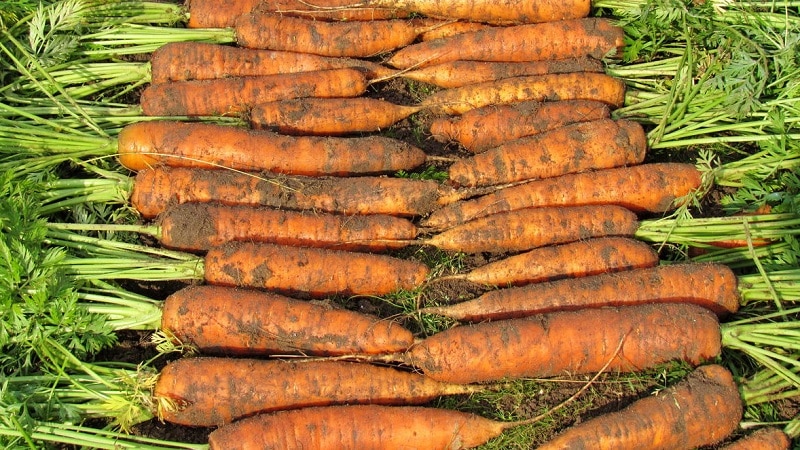
These are large varieties of carrots up to 30 cm long and up to 4 cm in diameter. The shape of the root crops is cylindrical, there is a core, but it is thin. Contains a lot of sugars and moisture. There are both early, middle and late varieties. This variety includes Nantes, Yaroslavna, Yaskrava, Samson, Kharkovskaya, Forto, Monanta, Rogneda, Nerak, Sirkana, Karadec, Cabana, etc.
Flakke, or Valeria
The variety is intended for long-term (winter) storage.They are classified as late ripening. The shape of the fruit is spindle-shaped or conical, length up to 25 cm, diameter up to 5 cm. The core is pronounced. Contains little sugar, moisture and carotene, which makes it easy to store. In terms of taste, it is inferior to early varieties.
This variety includes Victoria, Rote Risen, Autumn Karol, Flakenaria, Vita Longa.
Chantenay

Refers to mid-season. It has a large diameter of up to 6 cm, a length of up to 12 cm, and a cone-shaped root with a blunt end. The core is pronounced. Carrots are not suitable for storage and are used for direct consumption. The variety type includes Red Cor, Beauty Maiden, Katerina, Chantenay Royal, Kuroda.
Berlikumer
Ripens late, contains little carotene, but a lot of sugar. Suitable for winter storage. Juicy fruits measure up to 25 cm, and up to 5 cm in diameter. These include Darina, Berlikum, Morevna, Lakomka, Bangor.
Read also:
Features of red carrots without core.
The standard French variety of carrots is Carotel.
How to determine when to remove carrots from the garden for storage.
Minicarrot
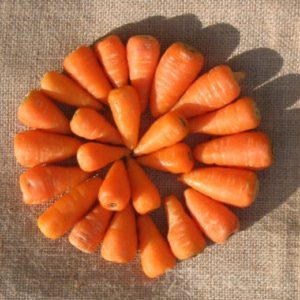
Dwarf root vegetables with a short length and a diameter of up to 3 cm, similar to radishes. They ripen quickly, but are not suitable for storage, only for freezing and canning. These include Parmex, Khibinskaya.
Paris carotel
It ripens early, is small in size, up to 10 cm long, and there are round specimens. Unsuitable for long-term storage, prone to cracking. Contains a lot of provitamin A. Representatives - Alenka, Polar cranberry.
Transitional types
These include:
- Flakke/Carotene. It is characterized by high productivity, long, up to 25 cm, diameter about 3 cm. It can crack, but is resistant to most diseases.Representative - Romos.
- Chantenay/Danvers. It has the shape of a cylinder, but with a pointed end. Resistant to cracking, fits well. Representative – Canada.
- Berlicum/Nantes. Larger than Nantes in length and width. It has the shape of a blunt-ended cylinder. Differs from Nantes varieties in less sweetness and carotene levels. But it is stored for a long time and gives a good harvest. Representatives - Baltimore F1, Nandrin.
Carrot varieties
Each of the varieties is represented by many varieties. The most common of them are Yaroslavna, Rogneda, Bolivar, Nantik, Karamelka, etc.
Mo
Late ripening. Mo carrots keep well and can withstand cold temperatures. The length of the root crops is up to 20 cm, the shape is conical. It has a high yield of about 7 kg per 1 sq. m. Stored until next year.
Canterbury
Average ripening time. The root crops are large – up to 300-700 g, conical. Canterbury carrots grow well in loose sandy loams and loams.
Sturdy
Ripens late. Keeps well until next year. Conical root vegetables 20 cm long. Strong carrots are used for nutrition in patients with anemia and nervous disorders. It was created precisely for this purpose.
Presto
Belongs to the Nantes type. Ripens early, period – 80 days. Resistant to arrow formation. Presto carrots are used for fresh consumption. Poorly stored.
Maestro
It takes a long time to ripen – 120-130 days. Does not crack. Belongs to the Nantes type. Length up to 20 cm, transverse size up to 4 cm. Weight of cylindrical fruits up to 200 g.
Bolivar
Belongs to the Chantenay type. Average ripening time is 110 days. Root vegetables are conical, with a smooth surface. Diameter up to 4-5 cm.Bolivar carrots have pronounced tops, do not crack, and easily adapt to temperature conditions. Well kept.
Narbonne F1
Late hybrid, bred in Holland. The ripening period is 135 days. Root vegetables are cylindrical. Narbonne F1 carrots are stored for a long time and have good taste.
Anastasia
Belongs to late varieties, ripens in 135 days. Nantes type. Carrot weight is about 100-150 g. Length is up to 22 cm. Anastasia carrots can be stored until spring and are not afraid of cracking.
Yaroslavna
Belongs to late varieties. Ripening occurs up to 120 days. However, to store the vegetable for the winter, you will need to wait 140-150 days. The pulp of Yaroslavna carrots is a rich orange color with a reddish tint, the length of the root crops is up to 22 cm.
September
Ripens in 120 days. The fruits are about 15-18 cm long. Weight is 100-200 g. The yield is approximately 400 centners per 1 ha. Suitable for storage.
Nantique Resistafly
Nantes carrots are thin, cylindrical, up to 15-19 cm long, about 3.5-4 cm in diameter, weighing about 100 g. They ripen quickly, in 90 days. The variety is not afraid of flowering and carrot flies.
Rogneda
Ripens in 108-115 days. The weight of the vegetable is about 100 g, length is up to 17 cm. Productivity is 6 kg per 1 sq. m.
Sweet tooth
The ripening period is about 120-130 days. Length 16-19 cm. Fruit weight 100-150 g. Productivity 300-450 c/ha. Intended for fresh consumption.
Chocolate Enchantress
Early ripening, ripens in 70 days. The roots are burgundy, the middle is orange, the core is yellow, indistinct. The taste is sweet. Carrots are not intended for storage.
Caramel
The vegetative period is 70-100 days. Size from 15 cm, weight 100-150 g. Combines good taste and excellent keeping quality.
Alenka
Blunt-ended vegetables, approximately 15 cm long and weighing 90-100 g, ripen in 85 days. Stored until autumn. Carrots are demanding of soil moisture and looseness.
Russian size
Carrots up to 30 cm long and weighing up to 1 kg ripen in 120-130 days.
Solomon
It grows to 25 cm in 80-100 days. It is stored until next year. Productivity – 230-400 c/ha.
Read also:
Large carrot variety Red Giant.
Carrot hybrid for long-term storage Canada f1.
What to do if someone gnaws carrots in the ground and how to deal with them.
Feed carrots
There are several types and subspecies of the vegetable used to feed livestock. This:
- White. It has high productivity. Species: Green-headed, Belgian, Arnimkriven.
- Yellow. It has more nutrients. Varieties: Belgian, Saalfelder.
- Red. Leads in the amount of vitamins. Types: Bull's heart, Gigantic.
Table carrots
Table species include high-yielding varieties:
- Carlena. Late carrots. The vegetative period is 150 days. Gives a yield of about 700 c/ha. The weight of root vegetables is 70 g.
- Losinoostrovskaya 13. Ripens in 100 days. Juicy, weighing up to 200 g. Productivity about 600 c/ha.

- Incomparable. Ripens in 105 days. Root crops weighing more than 200 g. Over 300 centners are collected from 1 hectare.
- Vitamin - sweet variety. Weight up to 160 g, yield up to 780 c/ha.
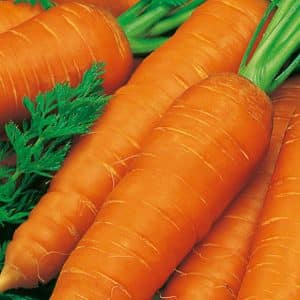
- Chantenay 2461. Ripens in 90 days. Productivity – from 600 centners per 1 ha. The weight of each root crop is up to 200 g. Length is up to 14 cm.
Varieties for long-term storage
They have good keeping quality:
- Cascade F1. Ripens in 125 days. Length up to 16 cm, diameter 6 cm. Belongs to the Chantenay variety. Loves warm, light soil.
- Moscow winter. Ripens in 70-90 days. Gives 3-6 kg per 1 sq. m. Representative of the Chantenay variety.
- Queen of Autumn - a late variety that grows in 130 days. Productivity 250-600 c/ha. Length up to 30 cm, weight up to 230 g. Belongs to the Flakke/Carotene type.
The best carrot varieties for north-west Russia
Suitable for the northwestern regions:
- Cardame F1 – late carrots. It has the shape of a blunt cone. The pulp is dark orange. Weight up to 150 g. Belongs to the Flakke type.
- Nanko – mid-season variety. Belongs to the Berlicum/Nantes type. Productivity 300-600 c/ha. Sugar content – 6-8%.
- Zafira – mid-season variety intended for winter storage. Weight up to 180 g. Yields 400-700 c/ha. Representative of the Berlicum/Nantes type.
- Princess grows in 120 days. Weight up to 130 g. Representative of the Amsterdam type.
- Chinese beauty reaches 20 cm, weighs up to 220 g. Suitable for long-term storage. Sweet, sugar content up to 9%.
- Soprano F1 - representative of the Nantes type. Grows in 110 days. Sugar content up to 11%. The weight of each vegetable is up to 170 g. The yield is 400-500 c/ha.
Coreless varieties
These include:
- Natalia - representative of the Nantes type. The result of the work of Dutch agronomists. Length up to 22 cm. Productivity 3-4 kg per 1 sq. m.
- Chicago F1 Grows about 17 cm in length in 95 days. Not suitable for long-term storage.
- Praline grows in 120 days. Length up to 22 cm. Suitable for making juices.
Features of wild carrots
Wild carrots grow in the southern regions of Ukraine and Russia. It is distinguished by its small root size and paler color. Contains essential oils, carotenoids, vitamins.
Important! Wild carrots are used as a diuretic for edema of various origins, an antispasmodic for intestinal and biliary colic and biliary dyskinesia.
It is used for vitamin A deficiency, although in fact it contains fewer carotenoids than in artificially bred species.
Top 5 most delicious varieties of carrots
These varieties have a high sugar content, so children and those with a sweet tooth love them. They are contraindicated in diabetes mellitus.
These include:
- Children's sweet. Ripens in 90-100 days. Productivity 6-8 kg per 1 sq. m. The weight of one vegetable is up to 200 g. The sugar content is about 7%.
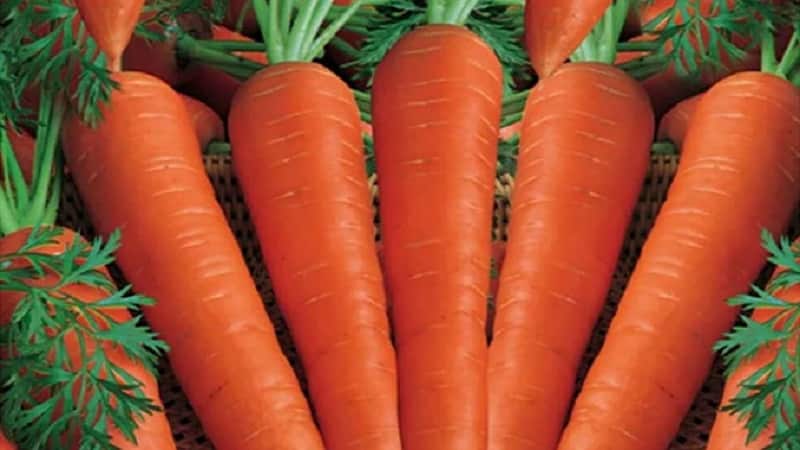 Children's sweet
Children's sweet - Emperor. Ripens in 120-130 days, has a modest yield of 2-4 kg per 1 sq. m. Vegetable weight up to 100 g.
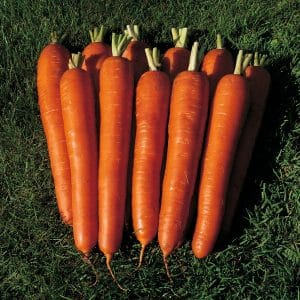 Emperor
Emperor - Nantes-4. The growing season is 90 days. Productivity 6-8 kg per 1 sq. m.
- Bolero F1. Ripens in 110 days, reaching a weight of 100-150 g. Sugar content up to 8%. Productivity 4-5 kg per 1 sq. m.
- Caramel. The growing season is 100 days. Weight up to 150-170 g. Productivity 2.5-4 kg per 1 sq. m. Sugar content up to 7.5%.
- Honey. Root crops ripen in 110 days, reaching a weight of 200 g. The yield is 2-4 kg per 1 sq. m. Contain about 6% sugar.
- The gourmet is mid-season. Weight 100-150 g. From 1 sq. m can be collected from 3 to 5 kg.
- Maestro F1. The mass of the root vegetable is 200 g. The sugar content reaches 6-7%. According to reviews from gardeners, Maestro F1 carrots are good for canning and eating raw.
Conclusion
All varieties of carrots have their advantages and disadvantages. Juicy vegetables do not store well, but they taste good and make healthy juices and smoothies. Carrots with good keeping quality should be sorted and dried before storage and left in a dry place. Then the harvest will last until spring.